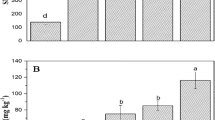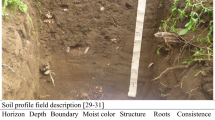Abstract
We tested whether levels of soil available nitrogen (N) and phosphorus (P) control the composition and function of the soil microbial community in a Brown Chernozemic soil on the Canadian Prairie. Soil dissolved organic carbon, N and P, and microbial communities structure (phospholipid fatty acid profile) and function (enzyme activity) were evaluated in the fallow and first wheat (Triticum aestivum L. cv. AC Eatonia) phases of fallow-wheat-wheat rotations where the wheat received soil test recommended rates of mineral N and P fertilizers (+N+P), or where N (−N+P) or P (+N−P) fertilizer use was withheld for 37 years. Differential fertilization modified soil N and P availability, and microbial community structure. Low N level was a major constraint when a rapidly growing wheat crop (heading stage) was drawing on the resource, reducing both plant N uptake and soil microbial biomass-C in −N+P soils. Available P level in +N−P soils was about half that measured in P-fertilized soils, but P did not limit plant productivity or microbial development at that time. Changes in the microbial community structure seemingly buffered the impact of lower P availability in +N−P soils. Phosphatase activity was not involved, but increased abundance of arbuscular mycorrhizal fungi might be associated with this effect. Low soil N availability explained lower specific denitrification and higher specific nitrogenase activities in −N+P soil growing wheat. Higher denitrification activity in +N+P soil could be attributed to higher soil C level and fertilization-induced shifts observed in the structure of the soil microbial community. Irrespective of the fertility level of the soil, all microbial communities grew at the relative growth rate of 17% day−1 in a nutrient limitation assay that revealed no C, N or P limitation in these communities. We conclude that mineral fertilization, which modifies soil available N and P fertility, can be a selective force causing structural and functional shifts in the soil microbial community with a resulting impact on soil quality and nutrient fluxes.





Similar content being viewed by others
References
Allen AS, Schlesinger WH (2004) Nutrient limitations to soil microbial biomass and activity in loblolly pine forests. Soil Biol Biochem 36:581–589 doi:10.1016/j.soilbio.2003.12.002
Allison VJ, Condron LM, Peltzer DA, Richardson SJ, Turner BL (2007) Changes in enzyme activities and soil microbial community composition along carbon and nutrient gradients at the Franz Josef chronosequence, New Zealand. Soil Biol Biochem 39:1770–1781 doi:10.1016/j.soilbio.2007.02.006
Anonymous (1976) Technicon Industrial Systems. 10591, Tarrytown, N.Y.
Baccanti M, Colombo B (1992) A new method for the automatic and selective determination of total organic carbon in sediments, soils, compost, particles in air, etc. Carlo Erba Instruments, Rodano
Bardgett RD, Lovell RD, Hobbs PJ, Jarvis SC (1999) Seasonal changes in soil microbial communities along a fertility gradient of temperate grasslands. Soil Biol Biochem 31:1021–1030 doi:10.1016/S0038-0717(99)00016-4
Bastiviken SK, Eriksson PG, Ekström A, Tonderski K (2007) Seasonal denitrification potential in wetland sediments with organic matter from different plant species. Water Air Soil Pollut 183:25–35 doi:10.1007/s11270-007-9352-x
Beauchamp EG, Bergstrom DW (1993) Denitrification. In: Carter MR (ed) Soil sampling and methods of analysis. Lewis, Boca Raton, pp 351–357
Bossio D, Scow K (1998) Impacts of carbon and flooding on soil microbial communities: phospholipids fatty acid profiles and substrate utilization patterns. Microb Ecol 35:265–278 doi:10.1007/s002489900082
Campbell CA, Zentner RP, Selles F, Jefferson PG, McConkey BG, Lemke R et al (2005) Long-term effect of crop** system on nitrogen and phosphorus fertilizer on production and nitrogen economy of grain crops in a Brown Chernozem. Can J Plant Sci 85:81–93
Campbell CA, VandenBygaart AJ, Grant B, Zentner RP, McConkey BG, Lemke R et al (2007) Quantifying carbon sequestration in a conventionally tilled crop rotation study in southwestern Saskatchewan. Can J Soil Sci 87:23–38
Chew V (1976) Comparing treatment means: a compendium. HortScience 11:348–357
Eivazi F, Tabatabai MA (1977) Phosphatases in soils. Soil Biol Biochem 9:167–172 doi:10.1016/0038-0717(77)90070-0
Elser JJ, Acharya K, Kyle M, Cotner J, Makino W, Markow T et al (2003) Growth rate-stoichiometry couplings in diverse biota. Ecol Lett 6:936–943 doi:10.1046/j.1461-0248.2003.00518.x
Fixen PE (2006) Soil test levels in North America. Better Crops 1:4–7
Frostegård A, Bååth E (1996) The use of phospholipid fatty acid analysis to estimate bacterial and fungal biomass in soil. Biol Fertil Soils 22:59–65 doi:10.1007/BF00384433
Garcia-Ruiz R, Baggs EM (2007) N2O emission from soil following combined application of fertilizer-N and ground weed residues. Plant Soil 299:263–274 doi:10.1007/s11104-007-9382-6
Hamel C, Hanson K, Selles F, Cruz A, Lemke R, McConkey B et al (2006) Seasonal and long-term resource-related variation in soil microbial communities in wheat-based rotations of the Canadian prairie. Soil Biol Biochem 38:2104–2116 doi:10.1016/j.soilbio.2006.01.011
Harrison KA, Bol R, Bardgett RD (2008) Do plant species with different growth strategies vary in their ability to compete with soil microbes for chemical forms of nitrogen. Soil Biol Biochem 40:228–237 doi:10.1016/j.soilbio.2007.08.004
Hodge A, Robinson D, Fitter A (2000) Are microorganisms more effective than plants at competing for nitrogen? Trends Plant Sci 5:304–308 doi:10.1016/S1360-1385(00)01656-3
Joergensen RG, Scheu S (1999) Response of soil microorganisms to the addition of carbon, nitrogen and phosphorus in a forest Rendzina. Soil Biol Biochem 31:859–866 doi:10.1016/S0038-0717(98)00185-0
Jonasson S, Castro J, Michelsen A (2006) Interactions between plants, litter and microbes in cycling of nitrogen and phosphorus in the arctic. Soil Biol Biochem 38:526–532 doi:10.1016/j.soilbio.2005.05.024
Kamphake LJ, Hannah SA, Cohen JM (1967) Automated analysis for nitrate by hydrazine reduction. Water Res 1:205–216 doi:10.1016/0043-1354(67)90011-5
Kelliher FM, Ross DJ, Law BE, Baldocchi DD, Rodda NJ (2004) Limitations to carbon mineralization in litter and mineral soil of young and old ponderosa pine forests. For Ecol Manag 191:201–213
Legendre P, Legendre L (1998) Numerical ecology. Developments in environmental modelling 20. Elsevier, Amsterdam
Manzoni S, Porporato A (2007) Theoretical analysis of nonlinearities and feedbacks in soil carbon and nitrogen cycles. Soil Biol Biochem 39:1542–1556 doi:10.1016/j.soilbio.2007.01.006
Marilley L, Arago M (1999) Phylogenetic diversity of bacterial communities different in degree of proximity of Lolium perenne and Trifolium repens roots. Appl Soil Ecol 13:127–136 doi:10.1016/S0929-1393(99)00028-1
Maynard DG, Karla YP (1993) Nitrate and exchangeable ammonium nitrogen. In: Carter MR (ed) Soil sampling and methods of analysis. Lewis, Boca Raton, pp 25–38
Montagna E, Torres BB (2008) Expanding ecological possibilities: Biological nitrogen fixation updated. Biochem Mol Biol Educ 36:99–105 doi:10.1002/bmb.20153
Nelson DR, Mele PM (2006) The impact of crop residue amendments and lime on microbial community structure and nitrogen-fixing bacteria in the wheat rhizosphere. Aust J Soil Res 44:319–329 doi:10.1071/SR06022
Newingham BA, Belnap J (2006) Direct effects of soil amendments on field emergence and growth of the invasive annual grass Bromus tectorum L. and the native perennial grass Hilaria jamesii (Torr.) Benth. Plant Soil 280:29–40 doi:10.1007/s11104-005-8551-8
Noel RJ, Hambleton LG (1976) Collaborative study of a semi-automated method for the determination of crude protein in animal feeds. J Assoc Anal Chem 59:134–140
Olsen SR, Cole CV, Watanabe FS, Dean LA (1954) Estimation of available phosphorus in soils by extraction with sodium bicarbonate. USDA circular 939. US Govt. Printing Office, Washington, DC
Olsson PA (1999) Signature fatty acids provide tools for determination of the distribution and interactions of mycorrhizal fungi in soil. FEMS Microbiol Ecol 29:303–310 doi:10.1111/j.1574-6941.1999.tb00621.x
Pankhurst CE, Pierret A, Hawke BG, Kirby JM (2002) Microbiological and chemical properties of soil associated with macropores at different depths in a red-duplex soil in NSW Australia. Plant Soil 238:11–20 doi:10.1023/A:1014289632453
Petersen SO, Klug MJ (1994) Effects of sieving, storage, and incubation temperature on the phospholipid fatty acid profile of a soil microbial community. Appl Environ Microbiol 60:2421–2430
Raynaud X, Lata JC, Leadley PW (2006) Soil microbial loop and nutrient uptake by plants: a test using a coupled C: N model of plant-microbial interactions. Plant Soil 287:95–116 doi:10.1007/s11104-006-9003-9
Rice WA, Olsen PE (1993) Root nodule bacteria and nitrogen fixation. In: Carter MR (ed) Soil sampling and methods of analysis. Lewis, Boca Raton, pp 303–317
Saikia SP, Jain V (2007) Biological nitrogen fixation with non-legumes: an achievable target or a dogma? Curr Sci 92:317–322
Scherrer B (1984) Biostatistique. G. Morin, Chicoutimi
Schoenau JJ, Karamanos RE (1993) Sodium BICARBONATE-Extractable P, K and N. In: Carter MR (ed) Soil sampling and methods of analysis. Lewis, Boca Raton, pp 51–58
Smith SE, Read DJ (1997) Mycorrhizal symbiosis. Academic, London
Smith VH, Graham DW, Cleland DD (1998) Application of resource-ratio theory to hydrocarbon biodegradation. Environ Sci Technol 32:3386–3395 doi:10.1021/es9805019
Speir TW, Ross DJ (1978) Soil phosphatase and sulphatase. In: Burns RG (ed) Soil Enzymes. Academic Press, New York, pp 197–250
Spring S, Schulze R, Overmann J, Schleifer K-H (2000) Identification and characterization of ecologically significant prokaryotes in the sediment of freshwater lakes: molecular and cultivation studies. FEMS Microbiol Rev 24:573–590 doi:10.1111/j.1574-6976.2000.tb00559.x
Stevenson FJ, Cole MA (1999) Cycles of soil: carbon, nitrogen, phosphorus, sulfur, micronutrients, 2nd edn. Wiley, New York
Sundareshwar PV, Morris JT, Koepfler EK, Fornwalt B (2003) Phosphorus limitation of coastal ecosystem processes. Science 299:563–565 doi:10.1126/science.1079100
Sundh I, Nilsson M, Borga P (1997) Variation in microbial community structure in two boreal peatlands as determined by analysis of phospholipid fatty acid profiles. Appl Environ Microbiol 63:1476–1482
Ullah S, Faulkner SP (2006) Use of cotton gin trash to enhance denitrification in resotred forested wetlands. For Ecol Manage 237:557–563 doi:10.1016/j.foreco.2006.09.075
van der Heijden MGA, Bardgett RD, van Straalen NM (2008) The unseen majority: Soil microbes as drivers of plant diversity and productivity in terrestrial ecosystems. Ecol Lett 11:296–310 doi:10.1111/j.1461-0248.2007.01139.x
Varley JA (1966) Automated method for the determination of nitrogen, phosphorus and potassium in plant material. Analyst (Lond) 91:119–126 doi:10.1039/an9669100119
Voroney RP, Winter JP, Beyaert RP (1993) Soil microbial biomass C and N. In: Carter MR (ed) Soil sampling and methods of analysis. Lewis, Boca Raton, pp 277–286
Xu X, Stange C, Richter A, Wanek W, Kuzyakov Y (2008) Light affects competition for inorganic and organic nitrogen between maize and rhizosphere microorganisms. Plant Soil 304:59–72 doi:10.1007/s11104-007-9519-7
Yao H, He Z, Wilson MJ, Campbell CD (2000) Microbial biomass and community structure in a sequence of soils with increasing fertility and changing land use. Microb Ecol 40:223–237
Zentner RP, Campbell CA, Selles F, Lemke R, McConkey BG, Fernandez MR et al (2007) Economics of spring wheat production systems using conventional tillage management in the Brown soil zone - Revisited. Can J Plant Sci 87:27–40
Acknowledgements
Authors are very grateful to anonymous reviewers. Part of this research was funded by a Discovery Grant of the Natural Sciences and Engineering Research Council of Canada to Hamel.
Author information
Authors and Affiliations
Corresponding author
Additional information
Responsible Editor: Tim Simon George.
Rights and permissions
About this article
Cite this article
Cruz, A.F., Hamel, C., Hanson, K. et al. Thirty-seven years of soil nitrogen and phosphorus fertility management shapes the structure and function of the soil microbial community in a Brown Chernozem. Plant Soil 315, 173–184 (2009). https://doi.org/10.1007/s11104-008-9742-x
Received:
Accepted:
Published:
Issue Date:
DOI: https://doi.org/10.1007/s11104-008-9742-x




